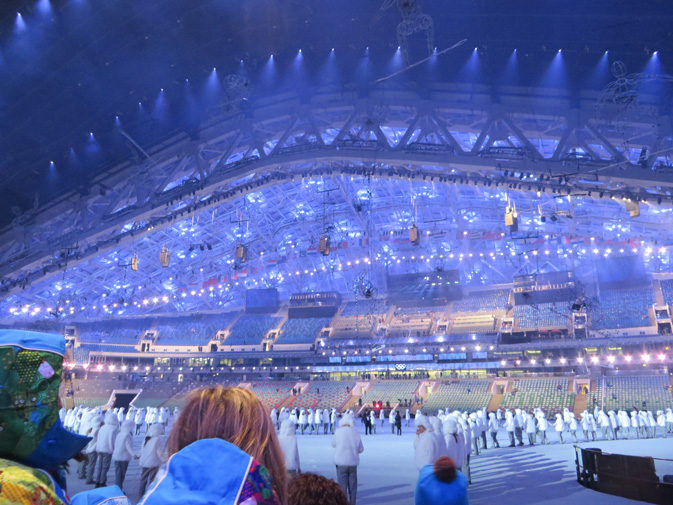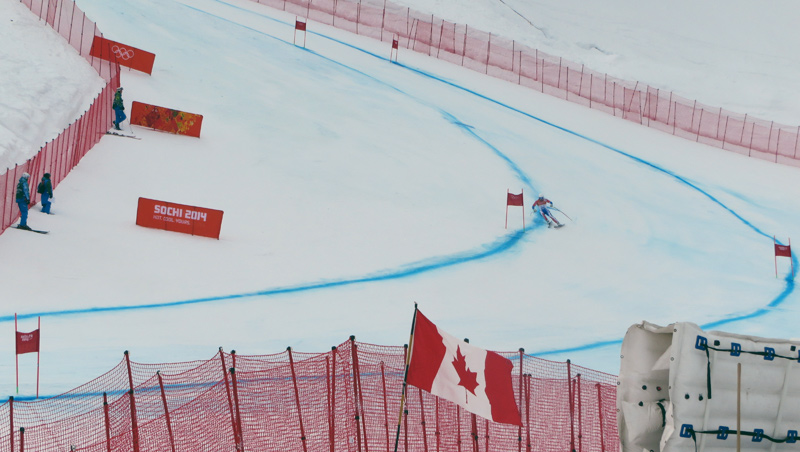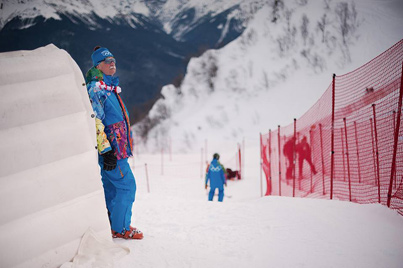 We’ve had great weather and both the men’s track and women’s track are taking shape. I believe there are close to 600 volunteers on each side.
We’ve had great weather and both the men’s track and women’s track are taking shape. I believe there are close to 600 volunteers on each side.
All World Cup ski races – no matter where – tend to have a similar organization: Race Organizing Committee, Chief of Race, Chief of Course, FIS pros, workers, etc. Here it seems the Russian Ski Federation marches to its own beat. There appears to be no regular crew chief meetings and communications. Whether it’s in Russian or English, it’s not regularly shared.
Most mornings it takes over 90 minutes to get the crews aligned and started. It’s very frustrating for the experienced volunteers that are here. I had to give our Team Leader some suggestions, only to be reprimanded! More on that later.
The Russians think they know it all when it come to World Cup races. They have one race under their belt, while some of us here have been working at World Cup races for many years at Whistler, Lake Louise and Vail. The French and Austrians volunteers have been doing the same thing. The Russians are paying no heed to anything we say. The organizing committee is lucky on the weather side and it looks like the men’s downhill will go on schedule.
The men’s track is wild. From the start the racer is launched on a very steep track part called the Toboggan with a hard left-footer, then it’s down to a fairly steep part called Estonia Tube, then a less steep part called Small Pan. The track then continues for about 400 metres to the Russian Trampoline and after that is the Big Pan, the widest part of the track. Then there’s a huge drop over Bear’s Brow (claimed to have a 55 degree pitch), another 200 metres, then Lake Jump (not as wild as Bear’s Brow), and this is followed by a short flat part then a last steep pitch called Deer Jump to the finish. It should be great to watch on TV.
You can tell we are getting closer to the Games – there are lots of international TV networks here. Broadcast trailers are filling up two football field-size lots. Increasing armed police presence, lots of Olympic branding going on, and lots of helicopter traffic. There are also several unmanned dirigibles that apparently have high definition cameras and heat sensing cameras.
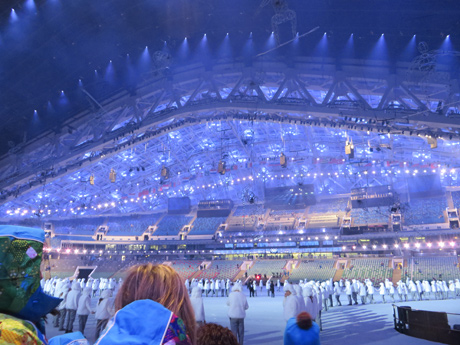 On Feb. 4 I was asked to volunteer to be part of a group of volunteers that will role-play as athletes marching in the stadium during the opening ceremonies. I was a member of the Norway team. It was a full on rehearsal and there were 80,000 people in the stands. There were 88 countries that marched in and the rest of the opening ceremonies are spectacular. Nobody was allowed to take photos but I do have a few shots that I took at the end when everything was over.
On Feb. 4 I was asked to volunteer to be part of a group of volunteers that will role-play as athletes marching in the stadium during the opening ceremonies. I was a member of the Norway team. It was a full on rehearsal and there were 80,000 people in the stands. There were 88 countries that marched in and the rest of the opening ceremonies are spectacular. Nobody was allowed to take photos but I do have a few shots that I took at the end when everything was over.
I am usually not emotional, but I could certainly get the feeling that athletes get when they are marching into the opening ceremonies and are hearing 80,000 cheering folks. Wow!
Prior to going the ceremonies we were taken to the Laura Cross-Country & Biathalon venue. To get to this venue we ride a gondola that rises to what seems like 2,000 feet. Apparently this venue is running events that are at the highest altitude allowed by FIS rules.
I asked where are we going and what are we doing there. Nobody could tell me anything in English or Russian. So we go up and were escorted into the secure athlete village and just walked around and walked back to the gondola. Finally a young person, who appeared to be the leader, explained they just wanted to see how long it would take crowds and athletes to walk about from the village to the competition venues and back to the gondola. Apparently, they had folks with stopwatches timing us. Well, at least I got to tour the Laura Centre, stadium, accommodations and get some great views.
Yesterday we were told that only the Russian Ski Federation pros would be allowed to ‘slip’ during competitions, much to the anger and frustration of international volunteers. Slipping is literally skiing sideways to shave the ruts created by a racer and to make the track as smooth as possible for the next racer.
I spoke to one of these pros, a young man who remembered me from last year’s test event. I asked him what he was doing, and he said slipping. I asked him if he had sharpened his edges because of the steepness and harness of the track. He said yes, but he was still scared to slip! Go figure! These are the Russian Federation ‘pros’ that we are supposed to take a back seat to.
It is difficult to accept, but at the end of the day it is their race, their Olympics and in their country. So I will smile and carry on.
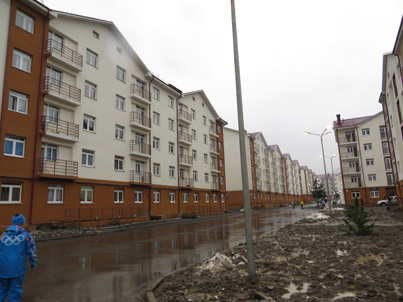 Many international volunteers are unhappy with this treatment and some are thinking about taking an early flight home. I am not happy, but I am staying. You never know what is going to happen. I am, after all, at the Olympic Winter Games in Sochi, Russia, working on the course and will take full advantage of my involvement here. This is probably my last Olympics opportunity.
Many international volunteers are unhappy with this treatment and some are thinking about taking an early flight home. I am not happy, but I am staying. You never know what is going to happen. I am, after all, at the Olympic Winter Games in Sochi, Russia, working on the course and will take full advantage of my involvement here. This is probably my last Olympics opportunity.
The volunteer village is like the athletes’ village, without all the bells and whistles. Folks from all over the world are here. We have been asked to display the flags of our nations. I brought along a map of the Fernie area and a big trail map of Fernie Alpine Resort so that international folks can get an idea as to why I am here and what my
homeland is like.
This place is now abuzz. We’ve had our first downhill training run and other sports are allowing athletes to practice. The opening ceremonies are less than 24 hours away!
